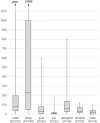Factors affecting the use of biosecurity measures for the protection of ruminant livestock and farm workers against infectious diseases in central South Africa
- PMID: 35306739
- PMCID: PMC9790579
- DOI: 10.1111/tbed.14525
Factors affecting the use of biosecurity measures for the protection of ruminant livestock and farm workers against infectious diseases in central South Africa
Abstract
Biosecurity measures have been introduced to limit economic losses and zoonotic exposures to humans by preventing and controlling animal diseases. However, they are implemented on individual farms with varying frequency. The goal of this study was to evaluate which biosecurity measures were used by farmers to prevent infectious diseases in ruminant livestock and to identify factors that influenced these decisions. We conducted a survey in 264 ruminant livestock farmers in a 40,000 km2 area in the Free State and Northern Cape provinces of South Africa. We used descriptive statistics, to characterize biosecurity measures and farm attributes, then multivariable binomial regression to assess the strength of the association between the attributes and the implementation of biosecurity measures including property fencing, separate equipment use on different species, separate rearing of species, isolation of sick animals, isolation of pregnant animals, quarantine of new animals, animal transport cleaning, vaccination, tick control and insect control. Ninety-nine percent of farmers reported using at least one of the 10 biosecurity measures investigated (median [M]: 6; range: 0-10). The most frequently used biosecurity measures were tick control (81%, 214 out of 264), vaccination (80%, 211 out of 264) and isolation of sick animals (72%, 190 out of 264). More biosecurity measures were used on farms with 65-282 animals (M: 6; odds ratio [OR]: 1.52) or farms with 283-12,030 animals (M: 7; OR: 1.87) than on farms with fewer than 65 animals (M: 4). Furthermore, farmers who kept two animal species (M: 7; OR: 1.41) or three or more species (M: 7) used more biosecurity measures than single-species operations (M: 4). Farmers with privately owned land used more biosecurity measures (M: 6; OR: 1.51) than those grazing their animals on communal land (M: 3.5). Farms that reported previous Rift Valley fever (RVF) outbreaks used more biosecurity measures (M: 7; OR: 1.25) compared with farms without RVF reports (M: 6) and those that purchased animals in the 12 months prior to the survey (M: 7; OR: 1.19) compared with those that did not (M: 6). When introducing new animals into their herds (n = 122), most farmers used fewer biosecurity measures than they did for their existing herd: 34% (41 out of 122) used multiple biosecurity measures like those of vaccination, tick control, quarantine or antibiotic use, whereas 36% (44 out of 122) used only one and 30% (37 out of 122) used none. Certain farm features, primarily those related to size and commercialization, were associated with more frequent use of biosecurity measures. Given the variation in the application of biosecurity measures, more awareness and technical assistance are needed to support the implementation of a biosecurity management plan appropriate for the type of farm operation and available resources.
Keywords: South Africa; biosecurity; farmers; ruminant production; zoonoses.
© 2022 The Authors. Transboundary and Emerging Diseases published by Wiley-VCH GmbH.
Conflict of interest statement
The authors of this manuscript declare no competing interests.
Figures




References
-
- African Union Inter‐African Bureau for Animal Resources . (2015). The Livestock Development Strategy for Africa (LiDeSA) 2015–2035: The roadmap to a successful livestock sector . Nairobi, Kenya: Retrieved from http://repository.au‐ibar.org/handle/123456789/540.
-
- Aliber, M. , Mabhera, S. , & Chikwanha, T. (2016). Agrarian reform and rural development. Commissioned research report for the high level panel on the assessment of key legislation and the acceleration of fundamental change. Alice, South Africa: High Level Panel University of Fort Hare, Alice, South Africa Retrieved from https://www.parliament.gov.za/storage/app/media/Pages/2017/october/High_....
-
- Andrew, M. , Shackleton, C. , & Ainslie, A. (2003). Land use and rural livelihoods: Have they been enhanced through land reform?. School of Government, University of the Western Cape, South Africa: Programme for Land and Agrarian Studies Retrieved from https://repository.uwc.ac.za/handle/10566/4245.
-
- Bellini, S. (2018). Technical item 1 : Application of biosecurity in different production systems at individual, country and regional levels. Paper presented at the 28th Conference of the OIE Regional Commission for Europe, Tbilisi, Georgia. https://www.oie.int/en/publications‐and‐documentation/compendium‐of‐tech...

